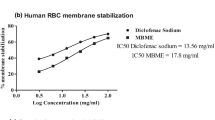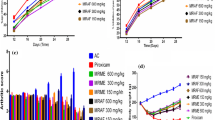Abstract
Reactive oxygen species (ROS) and reactive nitrogen species (RNS) are highly reactive transient chemical species, which play an important role in the etiology of tissue injury in rheumatoid arthritis (RA). The effects of milk extract of Semecarpus anacardium Linn. nut (SA) was studied on adjuvant arthritis in rats. Arthritis was induced by injecting 0.1 ml of heat killed mycobacterium tuberculosis (10 mg/ml of paraffin oil) intradermally into the left hind paw. A significant increase in the levels of lipid peroxides (LPO), ROS (superoxide radical, hydroxyl radical, H2O2 and myeloperoxidase) and RNS (nitrate+nitrite) observed in adjuvant arthritic animals were found to be significantly decreased on administration of the drug at 150 mg/kg body weight/day. The antioxidant defense system studied in arthritic animals were altered significantly as evidenced by the decrease in antioxidants. Treatment with SA recouped the altered antioxidant defense components to near normal levels. These evidences suggest that the free radical mediated damage during arthritis could have been controlled by SA by its free radical quenching and antioxidative potential. (Mol Cell Biochem 276: 97–104, 2005)
Similar content being viewed by others
References
Campo GM, Avenoso A, Campo S, Ferlazzo AM, Altavilla D, Calatroni A: Efficacy of treatment with glycosaminoglycans on experimental collagen-induced arthritis in rats. Arthritis Res Ther 5(3): R122–R130, 2003
Connor JR, Manning PT, Settle SL, Moore WM, Jetome GM, Webber RK, Tjoeng FS, Currie MG: Suppression of adjuvant-induced arthritis by selective inhibition of inducible nitric oxide synthase. Eur J Pharmacol 273: 15–24, 1995
Gutteridge JMC: Free radicals damage to lipids, amino acids, carbohydrates and nucleic acids, determined by TBA reactivity. Int J Biochem 14: 49–654, 1982
Windrow VR, Winyard PG, Morris CJ, Blake DR: Free radicals in inflammation: second messengers and mediators of tissue destruction. Br Med Bull 49: 506–522, 1993
Ralston SH: Nitric acid and bone: what a gas! Br J Rheumatol 36: 831–838, 1997
Moshtaghi Kashanian GR, Shapiro D: Rapid methods for analysis of nitrite and nitrate in serum of other biological fluids: Second Conference of Graduate Research on Medical Sciences Leuven, Belgium, April 1994
Nadkarni AK: Indian Materia Medica, 3rd edn, Popular Book Depot Ltd., Bombay, 1954, pp 1119–1121
Vijayalakshmi T, Muthulakshmi V, Sachdanandam P: Effect of milk extract of Semecarpus anacardium nut on adjuvant arthritis – a dose dependent study in wistar albino rats. Gen Pharmacol 27: 1223–1226, 1996
Pillai PP: Chemical examinations of making nuts (Semecarpus anacardium) J Ind Chem Soc 8: 517–523, 1931
Ramprasath VR, Shanthi P, Sachdanandam P: Anti-inflammatory effect of Semecarpus anacardium linn. nut extract in acute and chronic inflammatory conditions. Biol Pharm Bull 27(12): 2028–2031, 2004
Sathyavathi GV, Prasad DN, Singh HD: Anti-inflammatory activity of Semecarpus anacardium linn. A Preliminary study. Ind J Physiol Pharmacol 13: 37–43, 1969
Formulary of Siddha Medicine, 2nd edn, Indian Medicine Practitioners Co-operative Pharmacy and Stores Ltd., Madras, India, 1972, pp 197–198
Dodge JT, Mitchell C, Hanahan DJ: The preparation and chemical characteristics of hemoglobin-free ghosts of human erythrocytes. Arch Biochem Biophys 100: 119–130, 1963
Nishikimi M, Rao NA, Yagi K: Occurance of superoxide anion in the reaction of reduced phenazine methosulphate and molecular oxygen. Biochem Biophys Res Commun 46: 849–854, 1972
Wolff SP: Ferrous ion oxidation in presence of ferric ion indicator xylenol orange for measurement of hydroperoxides. Methods Enzymol 23: 180–189, 1994
Gutteridge JMC: Thiobarbituric acid-reactivity following iron-dependent free-radical damage to amino acids and carbohydrates. FEBS Lett 128: 343–346, 1981
Seekamp A, Michael SM, Till GO, Ward PA: Requirements for neutrophil products and l-arginine in ischemic-reperfusion injury. Am J Pathol 142: 217–1226, 1993
Marlund S, Marklund G: Involvement of superoxide anion radical in the autooxidation of pyrogallol and a convenient assay for superoxide dismutase. Eur J Biochem 47: 469–471, 1974
Sinha AK: Colorimetric assay of catalase. Anal Biochem 47: 380–390, 1979
Rotruk JT, Pope AL, Ganther HE, Swanson AB, Hafeman DG, Hekstra WG: Selenium, biochemical role as a component of glutathione peroxidase purification and assay. Science 179: 588–590, 1973
Habig WH, Papst MJ, Jacoby WH: Glutathione-S-transferases. The first enzymatic step in mercapturic acid formation. J Biol Chem 249: 7130–7139, 1974
Yagi K: Simple fluorimetric assay for lipoperoxide in blood plasma. Biochem Med 15: 212–216, 1976
Cynamon HA, Isenberg JN, Nguyen CH: Erythrocyte malondialdehyde release in vitro a fundamental studies, status in Vitamin E studies. Clin Chim Acta 15: 169–176, 1985
Devasagayam TP, Tarachand U: Decreased lipid peroxidation in the rat kidney during gestation. Biochem Biophys Res Commun 145: 469–474, 1987
Kerber S, Kelm M: Re-evaluation of the Griess method for determining NO3 < eqid1 > − in aqueous and protein containing samples. Nitric Oxide 3: 225–234, 1999
Bauerova K, Bezek A: Role of reactive oxygen and nitrogen species in etiopathogenesis of rheumatoid arthritis. Gen Physiol Biophys 18: 15–20, 1999
Knight JA: Free radicals, antioxidants, and the immune system. Ann Clin Lab Sci 30: 145–158, 2000
Morel F, Doussiere J, Vignais P: The superoxide generating oxidase of phagocytic cells. Physiological, molecular and pathological aspects. Eur J Biochem 201: 523–546, 1991
Iwamura H, Moore AR, Willoughby DA: Interaction between neutrophil derived elastase and reactive oxygen species in cartilage degradation. Biochim Biophys Acta 1156: 295–301, 1993
Furth RV, Berg BMV: Phagocytosis and intracellular killing of microorganisms by polymorphonuclear and mononuclear phagocytes. In: L.A. Herzenberg, D.M. Weir, B. Caroline (eds). Weir’s Handbook of Experimental Immunology, 5th edn, vol IV. Blackwell Science Inc, Oxford, 1996, pp 161.1–161.17
Ashok Kumar D, Manikandan P, Sumitra M, NarayanaRaju KVS, Gayathri C, Arutselvan N, Puvanakrishnan R: A novel peptide derivative exhibits anti-inflammatory and antioxidant activity in adjuvant induced arthritis in rats. Mol Cell Biochem 229: 9–17, 2002
Kaur H, Edmonds SE, Blake DR, Halliwell B: Hydroxyl radical generation by rheumatoid blood and knee joints synovial fluid. Ann Rheumatol Dis 55: 915–920, 1996
Ueki Y, Miyake S, Tominaga Y, Eguchi K: Increased nitric oxide levels in patients with rheumatoid arthritis. J Rheumatol 23: 230–236, 1996
Onur O, Akinei AS, Akbiyik F, Unsal I: Elevated levels of nitrate in rheumatoid arthritis. Rheumatol Int 20: 154–158, 2001
Lee J-C, Kim J, Park J-K, Chung G-H, Jang Y-S: The antioxidant, rather than prooxidant, activities of quercetin on normal cells: quercetin protects mouse thymocytes from glucose oxidase-meadiated apoptosis. Exp Cell Res 291: 386–397, 2003
Nijveldt RJ, van Nood E, van Hoorn DEC, Boelens PG, van Norren K, van Leeuwen PAM: Flavonoids; a review of probable mechanism of action and potential applications. Am J Clin Nut 74: 418–425, 2001
Tauber AI, Fay JR, Marletta MA: Flavonoid inhibition of the human neutrophil NADPH-Oxidase. Biochem Pharmacol 33(8): 13367–1369, 1984
Vijayalakshmi T, Muthulakshmi V, Sachdanandam P: Salubrious effect of Semecarpus anacardium against lipid peroxidative changes in adjuvant arthritis in rats. Mol Cell Biochem 175: 65–69, 1997
Marhoffer W, Stein M, Federlin K: Impaired function of polymorphonuclear neutrophilic granuloaacytes in rheumatoid arthritis. Immun Infekt 21(1): 15–26, 1993
Imadaya A, Terasawa K, Tosa H, Okamots M, Toriizuka K: Erythrocyte antioxidant enzymes are reduced in patients with Rheumatid arthitis. J Rhematol 15: 11.37, 1988
Rister M, Banchner RL: The alteration of SOD, catalase, glutathione peroxidase, NADPH, cytochrome c oxidase in guinea pig polymorphonuclear leukocytes and alveolar macrophage during hypoxia. J Clin Invest 58: 1174–1184, 1976
Zielinska M, Kostrzewa A, Ignatowicz E, Budzianowski J: The flavonoids, qucertin and isorhamnectin 3-O-acylglucosides diminish neutrophil oxidative metabolism and lipid peroxidation. Acta Biochimica Polonica 48: 183–189, 2001
Raj Narayanan K, Sripal reddy M, Chaluvadi MR, Krishna DR: Bioflavonoids classification, Pharmacological, biochemical effects and therapeutic potential. Ind J Pharmacol 33: 2–16, 2001
Ronzio B: Polyphenols as anti-inflammatory agents. J Naturopath Med 9: 44–50, 2000
Ward JR, Cloud S: Comparative effect of antirheumatic drugs on adjuvant induced polyarthritis in rats. J Pharmacol Exp Ther 152: 116–121–230, 1965
Arthus M: Injections repetees de serum de cheval cuez le lapin. Seances et Memoire de la Societe de Biologie 55: 817–825, 1903
Williams TJ: Prostaglandins E2, prostaglandin and vascular changes of inflammation. Br J Pharmacol 65: 517–524, 1979
Ramprasath VR, Shanthi P, Sachdanandam P: Evaluation of antioxidant effect of Semecarpus anacardium Linn. nut extract on the components of immune system in adjuvant arthritis. Vasc Pharmacol, in press
Author information
Authors and Affiliations
Rights and permissions
About this article
Cite this article
Ramprasath, V.R., Shanthi, P. & Sachdanandam, P. Semecarpus anacardium Linn. nut milk extract, an indigenous drug preparation, modulates reactive oxygen/nitrogen species levels and antioxidative system in adjuvant arthritic rats. Mol Cell Biochem 276, 97–104 (2005). https://doi.org/10.1007/s11010-005-3202-1
Received:
Accepted:
Issue Date:
DOI: https://doi.org/10.1007/s11010-005-3202-1




